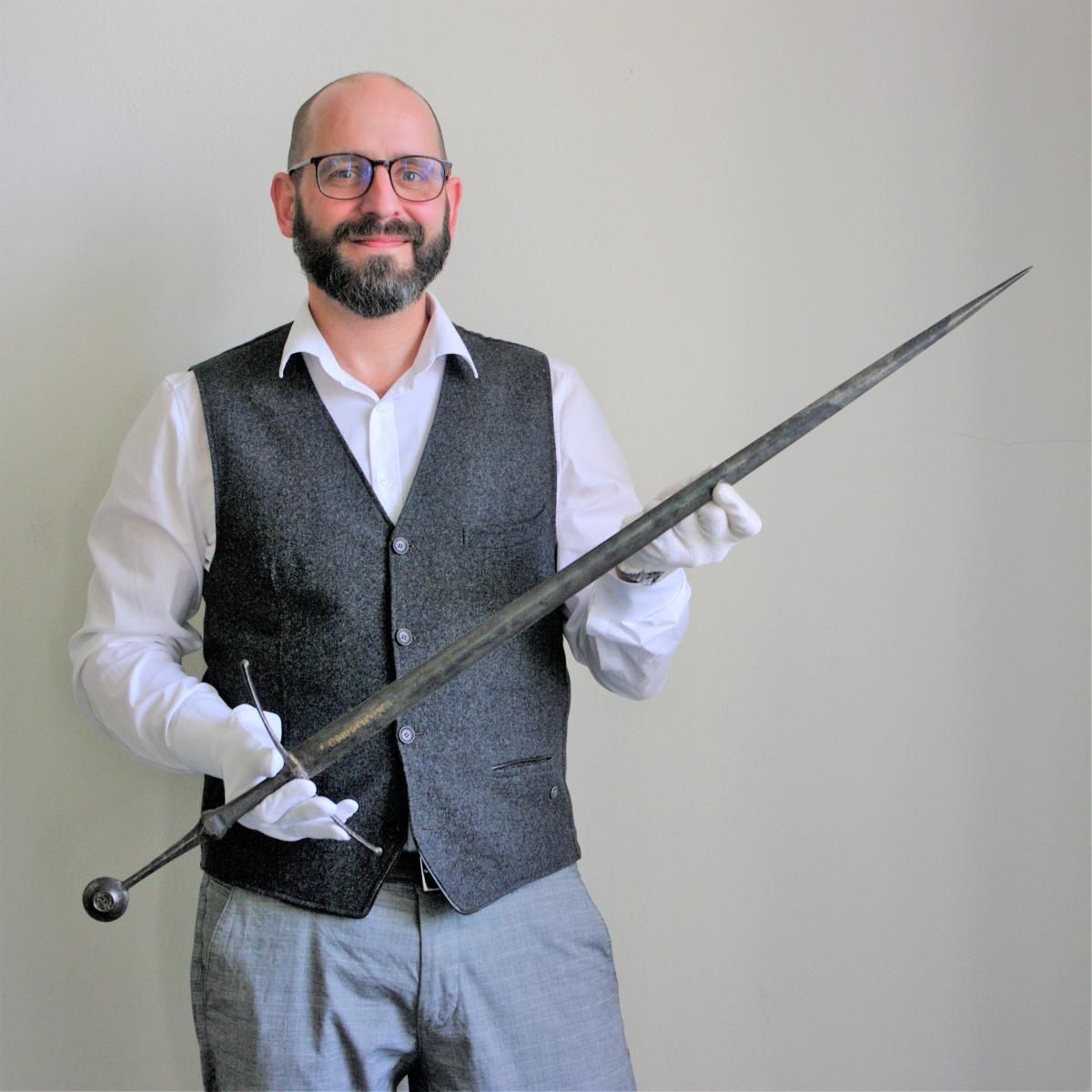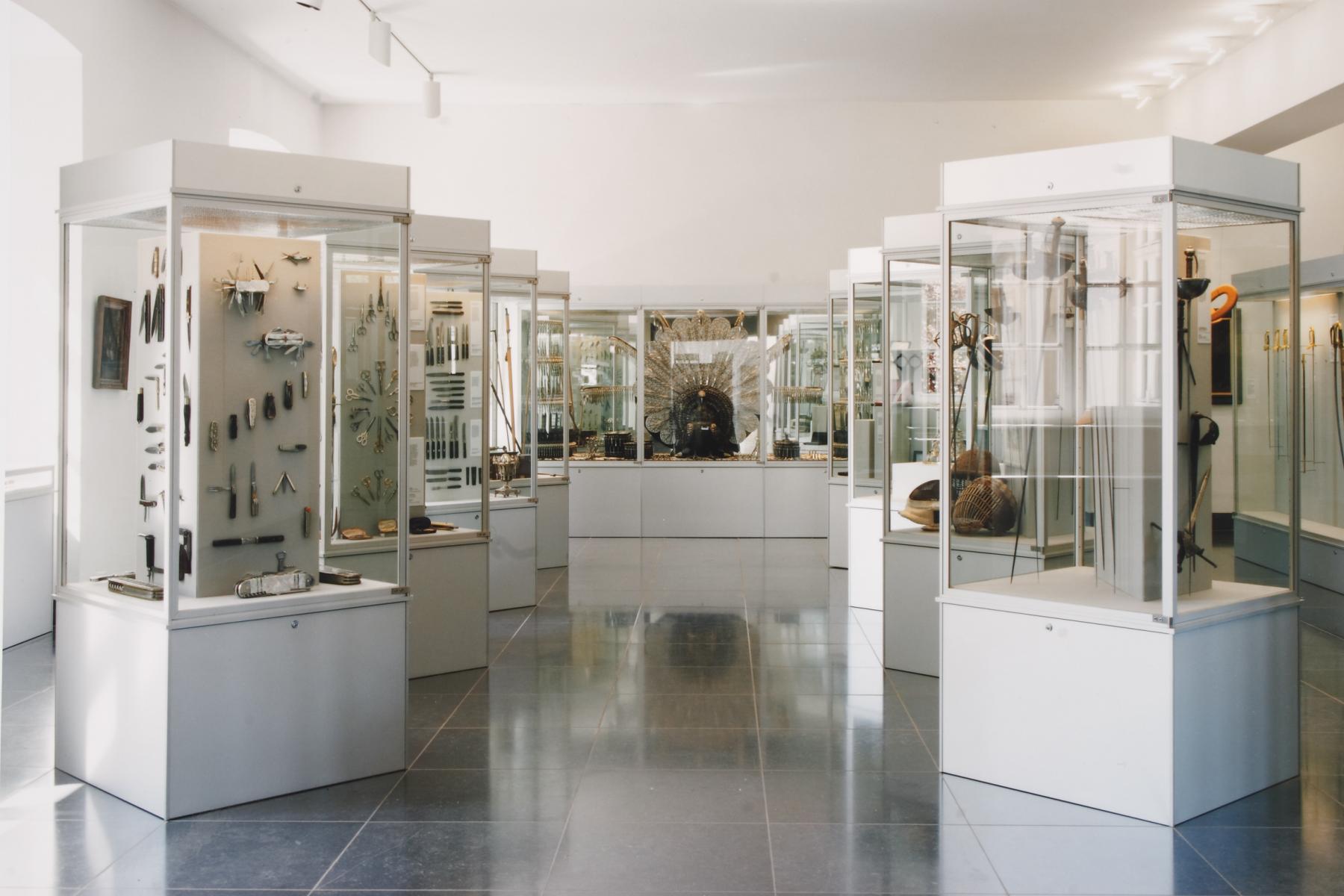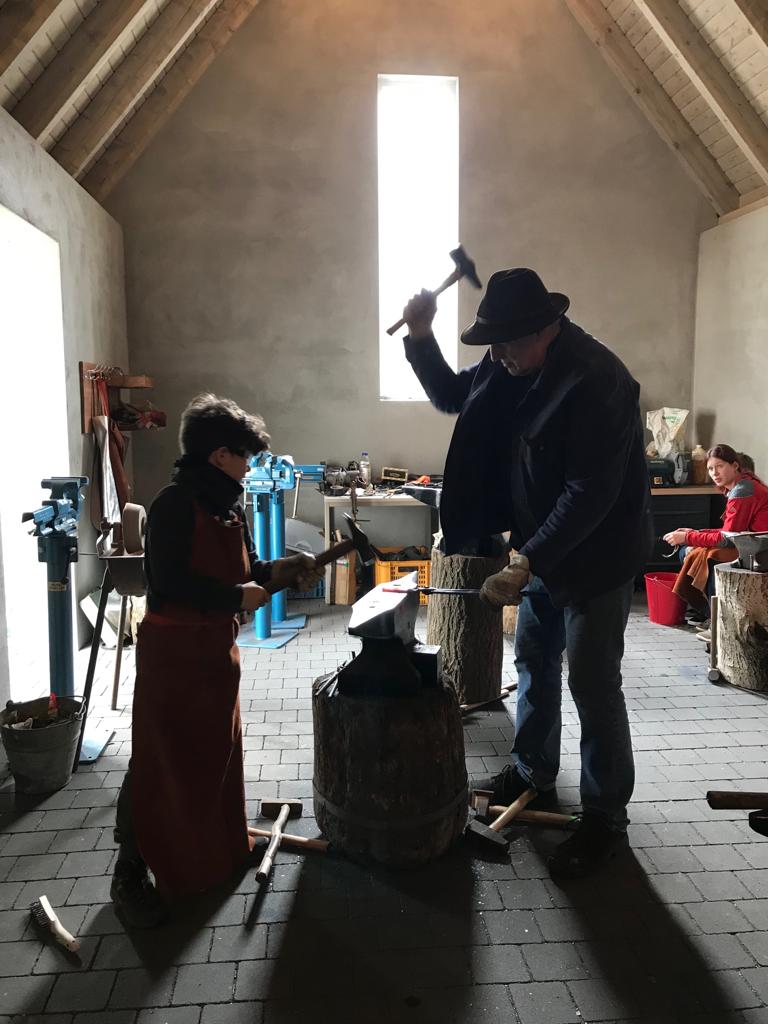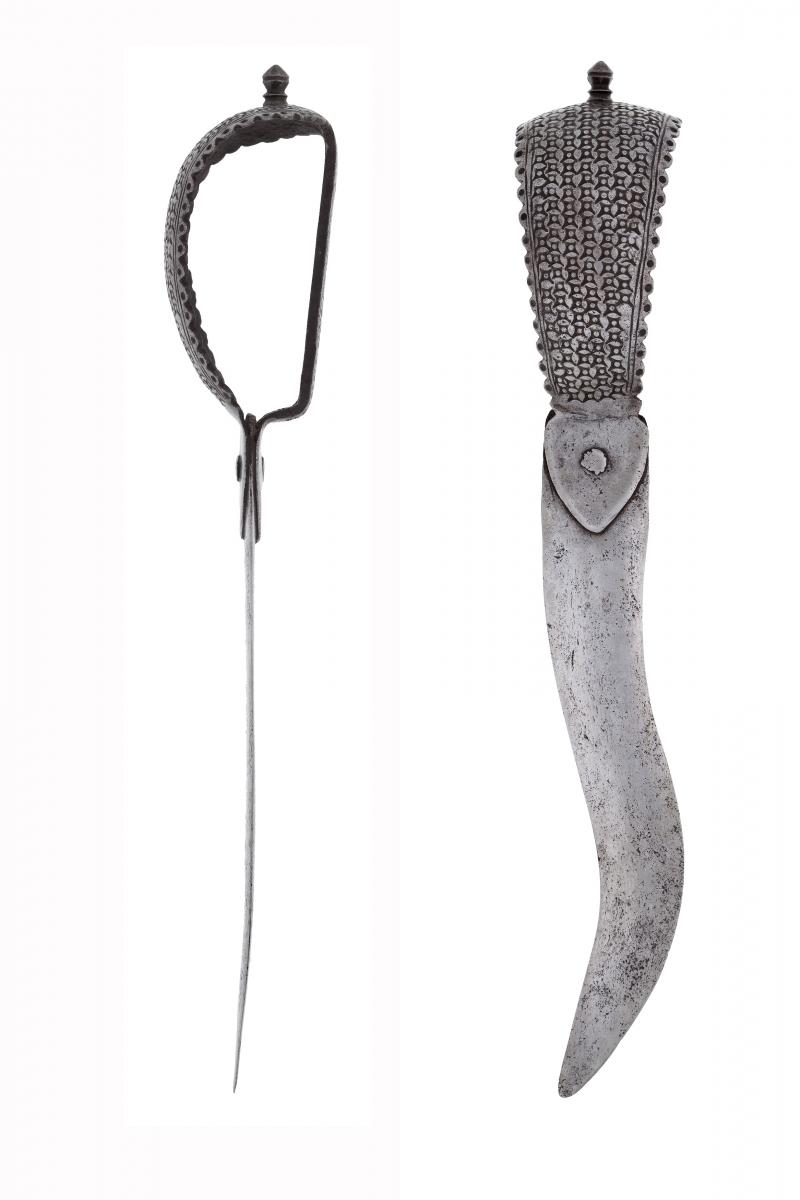The Deutsches Klingenmuseum
The Deutsches Klingenmuseum
 The Deutsches Klingenmuseum (German Blades Museum) in Solingen, heart of the German blade industry, is one of the largest blade museums in Europe - or perhaps even the largest. It has a magnificent collection, but the permanent exhibition has not changed since the museum moved into its current premises in 1991, in the restored monastery of Gräfrath. This means that - apart from the regular temporary exhibitions - the same objects have been on display for almost thirty years.
The Deutsches Klingenmuseum (German Blades Museum) in Solingen, heart of the German blade industry, is one of the largest blade museums in Europe - or perhaps even the largest. It has a magnificent collection, but the permanent exhibition has not changed since the museum moved into its current premises in 1991, in the restored monastery of Gräfrath. This means that - apart from the regular temporary exhibitions - the same objects have been on display for almost thirty years.Text Bas Martens, pictures Deutsches Klingenmuseum
So it has become time for change, but that is easier said than done. The major overhaul which the museum is planning will cost time and money, and both need to come from somewhere. Installations such as air conditioning and security need to be renewed. Furthermore there is, of course, the central question: what should the 'new' museum look like? What does it want to show, and in what way? And how can the new set-up of the museum fit in with its current location? The latter is important, because the museum is not planning to move out of the beautiful former convent, towering above the historical centre of Solingen-Gräfrath. It's an impressive place, but the building is listed as a monument, so the possibilities for change are limited.
To answer all these questions, the museum has invited a number of specialised companies to make a proposal for a future concept. Such a concept addresses the content side (such as the question which themes the museum wants to address and how these can be presented, questions that the museum itself has worked on intensively in the last years) but also the business side - what is the business concept, how do you attract tourists, is there competition? How is the accessibility? What are the strengths and weaknesses? The concept also serves as promotional material for sponsors, because that is where a large part of the money will have to come from. In short, the aim is ultimately to create a museum that is interesting both regionally and internationally. In the new set-up, the Klingenmuseum hopes to attract 35,000 visitors a year.

Museum director (after October 15) Dr. Sixt Wetzler with his favourite item: a possibly
German hand-and-a-halfsword, with inscription, horn hilt, and decorated pommel,
ca.1480 – 1500. Overall length 1050 mm.
Of the eight companies contacted, four reacted. Recently it was announced that the choice had fallen on bureau merz merz. If that name doesn't ring a bell: the company is one of the world's best in its field and was responsible for the design of the Mercedes-Benz museum in Stuttgart, among other things. The merz merz concept is due to be ready next summer. Then, a cost estimate can be made and sponsors can be sought. Throughout the entire process, the museum will remain open as much as possible. There may be temporary closures when major work is carried out on, for example, the electrical installations or climate control.
History
The Blade Museum has a somewhat chaotic history. After decades of planning and preparations, a Technical College for the Steelware Industry was established in Solingen in 1904. Its main goal was to give the workers in the Solingen steelware industry the possibility to gain further knowledge in their professions, which an emphasis on the graphic and design aspects.
It took another four years for the school to find a suitable place, but in 1908 students and teachers could move into a newly erected building. From the very start, a reference collection was built with samples of past Solingen products. This collection grew through acquisitions, presents and donations, and gradually became focussed on edged weapons, swords and rapiers from Solingen blade smiths. In 1929, this collection was formed into an independent 'Industrial Museum', which was established inside the walls of the Technical College and showed the history of the Solingen blade smiths and steelware industry.
Of the eight companies contacted, four reacted. Recently it was announced that the choice had fallen on bureau merz merz. If that name doesn't ring a bell: the company is one of the world's best in its field and was responsible for the design of the Mercedes-Benz museum in Stuttgart, among other things. The merz merz concept is due to be ready next summer. Then, a cost estimate can be made and sponsors can be sought. Throughout the entire process, the museum will remain open as much as possible. There may be temporary closures when major work is carried out on, for example, the electrical installations or climate control.
History
The Blade Museum has a somewhat chaotic history. After decades of planning and preparations, a Technical College for the Steelware Industry was established in Solingen in 1904. Its main goal was to give the workers in the Solingen steelware industry the possibility to gain further knowledge in their professions, which an emphasis on the graphic and design aspects.
It took another four years for the school to find a suitable place, but in 1908 students and teachers could move into a newly erected building. From the very start, a reference collection was built with samples of past Solingen products. This collection grew through acquisitions, presents and donations, and gradually became focussed on edged weapons, swords and rapiers from Solingen blade smiths. In 1929, this collection was formed into an independent 'Industrial Museum', which was established inside the walls of the Technical College and showed the history of the Solingen blade smiths and steelware industry.

For Centuries, Solingen blade smiths and companies have had a world-class reputation. They shipped
their products to all the corners of the globe.
After World War II, plans were made for an autonomous museum, outside the school, in order to show the ever expanding collection to the general public. The focus had expanded from local objects to edged weapons and cutlery from all times and places and the close connection to the Technical College had become anachronistic.
In 1954, the collection was moved to the former Town Hall of Gräfrath and re-opened under the present name 'Deutsches Klingenmuseum' (German Blades Museum). The museum continued to expand its two main areas, edged weapons and cutlery. The acquisition of two huge cutlery collections gave this part of the collection international importance. Simultaneously, all kinds of objects like paintings, graphics and sculptures depicting either the topic of weapons or the concept of table culture supported the magnificent collection. As the former Town Hall became too small, the museum moved again. In 1991 it was relocated to its present premises, the then recently restored Gräfrath Monastry.
In 1954, the collection was moved to the former Town Hall of Gräfrath and re-opened under the present name 'Deutsches Klingenmuseum' (German Blades Museum). The museum continued to expand its two main areas, edged weapons and cutlery. The acquisition of two huge cutlery collections gave this part of the collection international importance. Simultaneously, all kinds of objects like paintings, graphics and sculptures depicting either the topic of weapons or the concept of table culture supported the magnificent collection. As the former Town Hall became too small, the museum moved again. In 1991 it was relocated to its present premises, the then recently restored Gräfrath Monastry.


The museum collection runs from the Bronze Age (ca. 2500 B.C. to 500 B.C.) until the present day.
Trading places
Since 2016, the Klingenmuseum has been run by director Dr. Isabell Immel and her deputy Dr. Sixt Wetzler. Both remain attached to the museum, with one small difference: as from October 15 onward they will trade places. Sixt Wetzler will be the director, Isabell Immel his deputy. The reason is simple: the refurbishment of the museum will require a great deal of time and consultation in the coming years, often outside office hours. Dr Wetzler will have more opportunity to do so, so it was decided to change. Both worked very well together, and will continue to do so, but their change of position is the reason why only the new director will have a say here. And since he and I have known each other for quite some time, he is referred to by his first name in this article.
To get straight to the point, how did Sixt get his fascination with blades?
"My family always says they let me watch too much television as a child. When I was young you had the television series Sandokan. I had a toy sabre and I played Sandokan. These things often pass, but with me it stayed. When I was 11 years old I went with my parents to England and we visited the Royal Armouries, then still in London. That was an 'Erweckungserlebnis' (experience of enlightenment, ed.). So many edged weapons... That memory has accompanied me for years. In my school days I collected knives, I practised martial arts, martial arts with swords. The theme was always there. ”
Trading places
Since 2016, the Klingenmuseum has been run by director Dr. Isabell Immel and her deputy Dr. Sixt Wetzler. Both remain attached to the museum, with one small difference: as from October 15 onward they will trade places. Sixt Wetzler will be the director, Isabell Immel his deputy. The reason is simple: the refurbishment of the museum will require a great deal of time and consultation in the coming years, often outside office hours. Dr Wetzler will have more opportunity to do so, so it was decided to change. Both worked very well together, and will continue to do so, but their change of position is the reason why only the new director will have a say here. And since he and I have known each other for quite some time, he is referred to by his first name in this article.
To get straight to the point, how did Sixt get his fascination with blades?
"My family always says they let me watch too much television as a child. When I was young you had the television series Sandokan. I had a toy sabre and I played Sandokan. These things often pass, but with me it stayed. When I was 11 years old I went with my parents to England and we visited the Royal Armouries, then still in London. That was an 'Erweckungserlebnis' (experience of enlightenment, ed.). So many edged weapons... That memory has accompanied me for years. In my school days I collected knives, I practised martial arts, martial arts with swords. The theme was always there. ”

One of the museum rooms is dedicated to the 19th Century.
Wetzler studied Religious Studies, Medieval History and Scandinavian Studies and specialised in (North) Germanic Religion, for which he learned old Icelandic. His promotion was on battle scenes in Icelandic sagas and Medieval martial arts.
Following his studies, Sixt and three friends organised an international sword conference at Freiburg University, followed by a conference at the Deutsches Klingenmuseum in 2015. At that time he also became a freelance curator for the exhibition ‘The Sword – Form and Thought’ and finally joined the staff of the museum of which he now is the director. Sixt: "My sister said: there is only one job in Germany which fits you perfectly, and now you have it. And yes, this is like a dream come true. Isabel Immel has set ground-breaking milestones for the Klingenmuseum; the building of our own smithy, the transformation from MesserMacherMesse to KNIFE [see separate text-frame], and most of all, the development of a new Klingenmuseum. I am more than happy to continue this work."
Has he ever made a knife or sword? "No, I never had a desire to make them myself. I think my talents are elsewhere", Sixt says with a smile.
Following his studies, Sixt and three friends organised an international sword conference at Freiburg University, followed by a conference at the Deutsches Klingenmuseum in 2015. At that time he also became a freelance curator for the exhibition ‘The Sword – Form and Thought’ and finally joined the staff of the museum of which he now is the director. Sixt: "My sister said: there is only one job in Germany which fits you perfectly, and now you have it. And yes, this is like a dream come true. Isabel Immel has set ground-breaking milestones for the Klingenmuseum; the building of our own smithy, the transformation from MesserMacherMesse to KNIFE [see separate text-frame], and most of all, the development of a new Klingenmuseum. I am more than happy to continue this work."
Has he ever made a knife or sword? "No, I never had a desire to make them myself. I think my talents are elsewhere", Sixt says with a smile.


The German Blades Museum has the world’s largest collection of cutlery, a small part of which is exhibited
in the Pott Room.
Variety
The general collection theme of the museum is "Blades and cutting tools". Behind this simple term lies an incredibly rich variety of shapes, styles and materials, of all times and places. The collection runs from the Bronze Age (approximately 2500 B.C. to 500 B.C.) until the present day. Sixt: "We have a large collection., of about 30,000 objects. We do know quite well what we have. There is a staff member who has been taking photographs of the collection since the 1980s. We are also working on digitisation so that the collection can be accessed via the Internet. There is not much chance that we will discover anything outstanding in the process that we hadn’t known before. But we still receive donations all the time and we have sponsors who help us with purchases. ”
Variety
The general collection theme of the museum is "Blades and cutting tools". Behind this simple term lies an incredibly rich variety of shapes, styles and materials, of all times and places. The collection runs from the Bronze Age (approximately 2500 B.C. to 500 B.C.) until the present day. Sixt: "We have a large collection., of about 30,000 objects. We do know quite well what we have. There is a staff member who has been taking photographs of the collection since the 1980s. We are also working on digitisation so that the collection can be accessed via the Internet. There is not much chance that we will discover anything outstanding in the process that we hadn’t known before. But we still receive donations all the time and we have sponsors who help us with purchases. ”

In normal times, the museum organises martial art classes for children with sword fighting.
The collection area consists of several themes. In random order they are cutlery (the largest collection in the world); edged weapons; cutting tools such as razors and scissors; paintings, drawings and manuscripts on the theme of blades; fencing books from the 16th Century onward; catalogues and sample books; and company archives, such as that of the Pott company. In addition, the museum has an extensive library.
In dealing with these different collection areas, the museum has several guidelines. First and foremost, everything revolves about the object - which in part speaks for its self. But the object has a maker, and the maker has a history, so there are many stories waiting to be told. The museum's experience is that these stories are best told by a human guide. "If you, as a guide, have a fascination for the subject yourself, the story comes across much better", Sixt explains. If time permits - which to his regret it rarely does - he still likes to gives tours himself.
Finally, the museum wants to organise and promote activities. "Objects are dead if you don't know their purpose and how to use them", says Sixt. Therefore, the museum organises martial art classes for children with sword fighting, demonstrations of pewter casting, classes in bronze casting. Since two years the museum has a fully functional forging workshop as well, for demonstrations and courses. Regrettably, most of these have been temporarily halted because of the Covid pandemia.
In dealing with these different collection areas, the museum has several guidelines. First and foremost, everything revolves about the object - which in part speaks for its self. But the object has a maker, and the maker has a history, so there are many stories waiting to be told. The museum's experience is that these stories are best told by a human guide. "If you, as a guide, have a fascination for the subject yourself, the story comes across much better", Sixt explains. If time permits - which to his regret it rarely does - he still likes to gives tours himself.
Finally, the museum wants to organise and promote activities. "Objects are dead if you don't know their purpose and how to use them", says Sixt. Therefore, the museum organises martial art classes for children with sword fighting, demonstrations of pewter casting, classes in bronze casting. Since two years the museum has a fully functional forging workshop as well, for demonstrations and courses. Regrettably, most of these have been temporarily halted because of the Covid pandemia.


Left: Demonstrations of pewter casting. Right: Since two years the museum has a fully functional forging
workshop, for demonstrations and courses.
Solingen and the world
The German Blades Museum finds itself in a somewhat peculiar situation. One on hand it is a regional museum, with most of the funding coming from the city of Solingen, reflecting the rich history as the centre of the German blade-making industry. On the other hand, it is an international museum, not only because of the importance of its collection, but also because most of these Solingen companies had a world-class reputation and shipped their products to all the corners of the globe.
It is a bit of a split, Sixt Wetzler admits. "We try to be equally interesting to a school class from Solingen and a Finnish sword collector. And yes, we get a lot of international visitors. But the emphasis is on 'Solingen Klingenstadt' (Solingen Blade City). We believe that is interesting for everyone. ”
For more information: www.klingenmuseum.de (in German and English).
Solingen and the world
The German Blades Museum finds itself in a somewhat peculiar situation. One on hand it is a regional museum, with most of the funding coming from the city of Solingen, reflecting the rich history as the centre of the German blade-making industry. On the other hand, it is an international museum, not only because of the importance of its collection, but also because most of these Solingen companies had a world-class reputation and shipped their products to all the corners of the globe.
It is a bit of a split, Sixt Wetzler admits. "We try to be equally interesting to a school class from Solingen and a Finnish sword collector. And yes, we get a lot of international visitors. But the emphasis is on 'Solingen Klingenstadt' (Solingen Blade City). We believe that is interesting for everyone. ”
For more information: www.klingenmuseum.de (in German and English).

A small collection of Field Swords.

Edged weapons from all times and places.

Knives and cutting tools comes in all shapes and sizes, for all kinds of professional use.


Left: A Frankish sword from the famous maker/workshop INGELRII with gold overlays, ca 1000.
Right: A rapier with fire-gilded decoration, ca 1600.


Left: Parrying dagger with gilded decoration, ca 1600.
Right: An executioner’s sword, the blade from Solingen blade smith Peter Munich, 17th Century.
Right: An executioner’s sword, the blade from Solingen blade smith Peter Munich, 17th Century.


Left: A koftgari-decorated small sword with Colichemarde blade, second half 18th Century.
Right: A hunting sword with decorated bronze elements and fish-skin hilt, ca 1825 – 1850.


Left: A South Indian pata sword with Solingen blade, 17th Century.
Right: A sickle knife of the Mangbetu, Kongo, hilt with brass and iron bands, before 1960.




Left: A Central Indian bichwa dagger, 18th Century.
Right: A Javanese wedung with intricate pamor pattern, gold decoration, and hilt from elephant tooth, 17th Century.
KNIFE Solingen
The Klingenmuseum in Solingen has long been the venue for the annual knife show called MesserMacherMesse, organised in cooperation with the Deutsche Messermacher Guild (Geman Knife Makers Guild). The museum was no longer suitable for this purpose and so it was decided to set up a new fair with a broader scope: KNIFE Solingen, organised by the museum, the town of Solingen, the guild and the Industrieverband Schneid- und Haushaltswaren (Association of Cutlery and Houseware Industry). This fair was to be held for the first time on 9 and 10 May this year, at the Solingen Theatre and Concert Hall. There were already almost 180 applications from exhibitors, but unfortunately the Corona virus spoiled it all. The fair was cancelled at the last moment. As a “remedy”, an online version of the show has been installed: www.knife-solingen.de/knife-online-en.
In the meantime, it has been decided to cancel the 2021 edition as well. In order to organise the fair as planned, preparations would have to start now and considerable expenses would have to be incurred. However, the situation surrounding the Covid pandemic is such that it is not certain whether the fair can go ahead next year. To be on the safe side, it has now been postponed for one more year, to 2022. Instead, a less elaborate Day of the Knife will be held in mid-May 2021. As soon as more information is available, this will be included in the European Blades Mag. agenda on this website.
In the meantime, it has been decided to cancel the 2021 edition as well. In order to organise the fair as planned, preparations would have to start now and considerable expenses would have to be incurred. However, the situation surrounding the Covid pandemic is such that it is not certain whether the fair can go ahead next year. To be on the safe side, it has now been postponed for one more year, to 2022. Instead, a less elaborate Day of the Knife will be held in mid-May 2021. As soon as more information is available, this will be included in the European Blades Mag. agenda on this website.